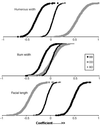Genetic basis for systems of skeletal quantitative traits: principal component analysis of the canid skeleton
- PMID: 12114542
- PMCID: PMC126602
- DOI: 10.1073/pnas.152333099
Genetic basis for systems of skeletal quantitative traits: principal component analysis of the canid skeleton
Abstract
Evolution of mammalian skeletal structure can be rapid and the changes profound, as illustrated by the morphological diversity of the domestic dog. Here we use principal component analysis of skeletal variation in a population of Portuguese Water Dogs to reveal systems of traits defining skeletal structures. This analysis classifies phenotypic variation into independent components that can be used to dissect genetic networks regulating complex biological systems. We show that unlinked quantitative trait loci associated with these principal components individually promote both correlations within structures (e.g., within the skull or among the limb bones) and inverse correlations between structures (e.g., skull vs. limb bones). These quantitative trait loci are consistent with regulatory genes that inhibit growth of some bones while enhancing growth of others. These systems of traits could explain the skeletal differences between divergent breeds such as Greyhounds and Pit Bulls, and even some of the skeletal transformations that characterize the evolution of hominids.
Figures



References
-
- Evans H E. Miller's Anatomy of the Dog. Philadelphia: Saunders; 1993.
-
- Vila C, Savolainen P, Maldonado J E, Amorim I R, Rice J E, Honeycutt R L, Crandall K A, Lundeberg J, Wayne R K. Science. 1997;276:1687–1689. - PubMed
-
- Molinari C. The Portuguese Water Dog. Portugal: ELO-Publicidade; 1993. pp. 1–156.
-
- Chase K, Adler F R, Miller-Stebbings K, Lark K G. J Hered. 1999;90:43–51. - PubMed
-
- Jackson J E. A User's Guide to Principal Components. New York: Wiley; 1991.
Publication types
MeSH terms
Substances
Grants and funding
LinkOut - more resources
Full Text Sources
Other Literature Sources

